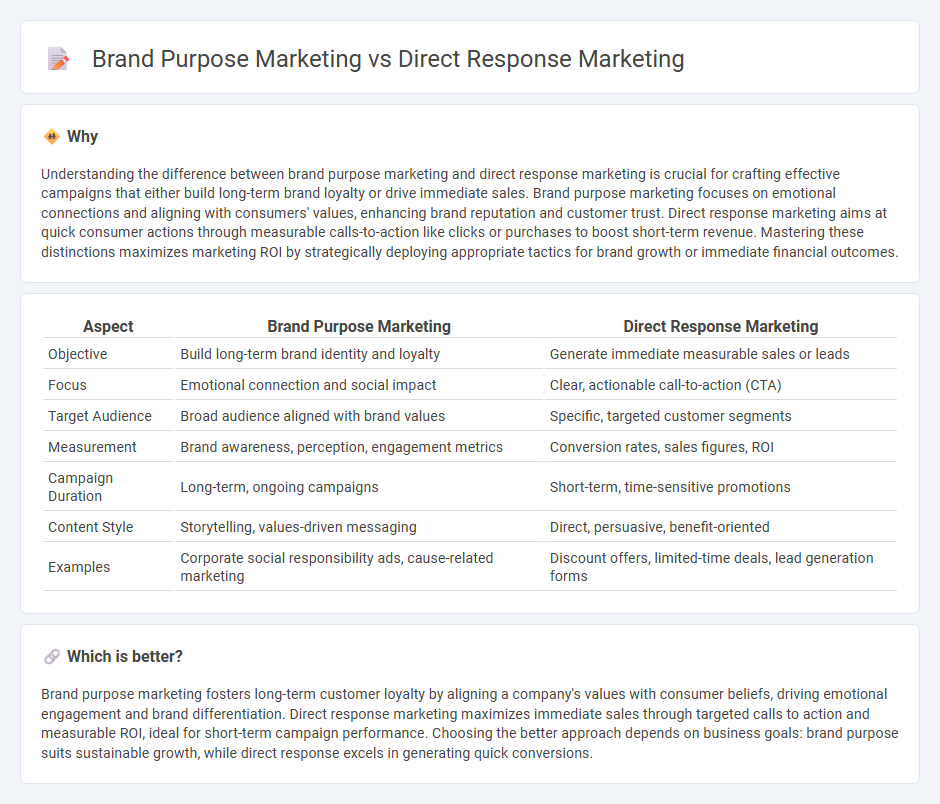
Brand purpose marketing focuses on building long-term relationships by aligning a company's mission with customer values, fostering loyalty and emotional connections. Direct response marketing targets immediate actions through clear calls-to-action and measurable results, optimizing for quick conversions and sales. Discover how these strategies can transform your marketing approach and drive business growth.
Why it is important
Understanding the difference between brand purpose marketing and direct response marketing is crucial for crafting effective campaigns that either build long-term brand loyalty or drive immediate sales. Brand purpose marketing focuses on emotional connections and aligning with consumers' values, enhancing brand reputation and customer trust. Direct response marketing aims at quick consumer actions through measurable calls-to-action like clicks or purchases to boost short-term revenue. Mastering these distinctions maximizes marketing ROI by strategically deploying appropriate tactics for brand growth or immediate financial outcomes.
Comparison Table
| Aspect | Brand Purpose Marketing | Direct Response Marketing |
|---|---|---|
| Objective | Build long-term brand identity and loyalty | Generate immediate measurable sales or leads |
| Focus | Emotional connection and social impact | Clear, actionable call-to-action (CTA) |
| Target Audience | Broad audience aligned with brand values | Specific, targeted customer segments |
| Measurement | Brand awareness, perception, engagement metrics | Conversion rates, sales figures, ROI |
| Campaign Duration | Long-term, ongoing campaigns | Short-term, time-sensitive promotions |
| Content Style | Storytelling, values-driven messaging | Direct, persuasive, benefit-oriented |
| Examples | Corporate social responsibility ads, cause-related marketing | Discount offers, limited-time deals, lead generation forms |
Which is better?
Brand purpose marketing fosters long-term customer loyalty by aligning a company's values with consumer beliefs, driving emotional engagement and brand differentiation. Direct response marketing maximizes immediate sales through targeted calls to action and measurable ROI, ideal for short-term campaign performance. Choosing the better approach depends on business goals: brand purpose suits sustainable growth, while direct response excels in generating quick conversions.
Connection
Brand purpose marketing and direct response marketing are connected through their shared goal of fostering meaningful consumer engagement that drives action. Brand purpose marketing builds trust and emotional connection by aligning with customer values, which enhances the effectiveness of direct response campaigns by motivating immediate consumer responses. Leveraging purpose-driven messaging in direct response marketing increases conversion rates by tapping into deeper brand loyalty and authenticity.
Key Terms
**Direct Response Marketing:**
Direct Response Marketing drives immediate consumer action through clear, compelling calls-to-action and measurable outcomes like clicks, leads, or sales. It leverages targeted campaigns such as email marketing, pay-per-click ads, and direct mail to generate quick returns on investment. Explore the strategic benefits and implementation tactics of Direct Response Marketing to maximize your marketing impact.
Call to Action (CTA)
Direct response marketing emphasizes a clear, urgent Call to Action (CTA) designed to generate immediate customer responses such as purchases, sign-ups, or inquiries. Brand purpose marketing integrates the CTA within a broader narrative that highlights a company's values and mission, aiming to build long-term customer loyalty and emotional connection. Explore how combining effective CTAs with strong brand purpose can maximize marketing impact.
Conversion Rate
Direct response marketing emphasizes immediate consumer actions to maximize conversion rates through targeted calls-to-action and measurable campaigns. Brand purpose marketing builds long-term customer loyalty by aligning messaging with core values, often resulting in slower but sustained conversion growth. Explore how these strategies can optimize your conversion rate by balancing immediate sales and lasting brand affinity.
Source and External Links
What is Direct Response Marketing and Advertising? - Direct response marketing is designed to elicit an instant response by encouraging prospects to take a specific action, aiming to generate leads quickly and show immediate ROI, unlike traditional marketing focused on long-term brand awareness.
10 Direct Response Marketing Examples - Neil Patel - This strategy seeks to turn prospects into customers immediately by packaging the value proposition, pitch, and CTA in one place, and includes channels like landing pages, social media ads, and TV commercials to prompt immediate action and fast ROI.
What Is a Direct Response Ad? - HubSpot Blog - Direct response marketing is customer-centric, targeted, offer-centric, and urgent with calls-to-action that provoke quick responses, often using personalized messages and a sense of urgency to drive immediate conversions.
 dowidth.com
dowidth.com